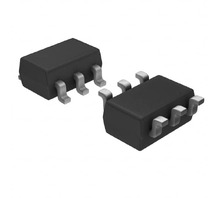Manufacturer Part Number
TLV3501AZQDBVRQ1
Manufacturer
Texas Instruments
Introduction
The TLV3501AZQDBVRQ1 is a high-speed, single-channel linear comparator from Texas Instruments, designed for automotive and general-purpose applications.
Product Features and Performance
General purpose comparator
Single channel operation
Output types: CMOS, Push-Pull, Rail-to-Rail, TTL
High speed with a maximum propagation delay of 10ns
Low input offset voltage: 6.5mV at 5.5V
Maximum input bias current: 10pA at 5.5V
High Common-Mode Rejection Ratio (CMRR): 70dB
High Power Supply Rejection Ratio (PSRR): 100dB
Operating temperature range from -40°C to 125°C
Automotive grade and AEC-Q100 qualified
Product Advantages
Ultra fast response suitable for time-critical applications
Highly precise with low input bias and offset
Robust output type compatibility enhances integration flexibility
Excellent temperature stability and reliability
Key Technical Parameters
Voltage Supply Range: Single: 2.7V ~ 5.5V, Dual: ±1.35V ~ 2.75V
Quiescent Current (Max): 5mA
Hysteresis: 6mV
CMRR, PSRR (Typ): 70dB CMRR, 100dB PSRR
Propagation Delay (Max): 10ns
Quality and Safety Features
AEC-Q100 qualification ensures automotive reliability and performance
CMOS, Push-Pull, Rail-to-Rail, TTL output configurations promote safe interfacing
Compatibility
Compatible with various supply voltages and interfacing standards for broader application use
Application Areas
Automotive electronics
Industrial measurement systems
Communication equipment
Data acquisition systems
Product Lifecycle
Currently in Active production status
No impending discontinuation announced, ensuring long-term availability and support
Several Key Reasons to Choose This Product
High-speed operation enhances system responsiveness and performance
Stringent quality standards, including AEC-Q100 qualification, ensure reliability in automotive conditions
Low power consumption makes it suitable for power-sensitive applications
Wide operating temperature range allows deployment in harsh environments
Flexibility with multiple logic-level output compatibility offers system design versatility



 TLV3501AIDG4Texas Instruments
TLV3501AIDG4Texas Instruments TLV3502AIDTexas InstrumentsIC COMPARATOR 2 GEN PUR 8SOIC
TLV3502AIDTexas InstrumentsIC COMPARATOR 2 GEN PUR 8SOIC